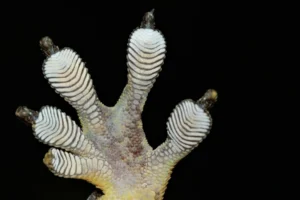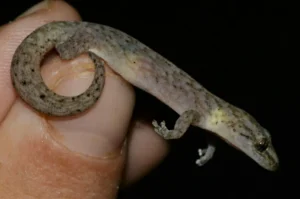Imagine gently placing your hand near a gecko’s enclosure. A tiny crested gecko climbs up, pauses, and suddenly it’s on your hand, clinging there like gravity doesn’t exist. You instinctively wonder, do geckos stick to skin the same way they climb walls and ceilings?
Yes, geckos can stick to your skin, but it’s not permanent glue. They use microscopic hair-like structures on their toes called setae, which let them hold onto smooth and rough surfaces. Human skin is usually sticky enough for them to grip, but they can also detach easily without hurting themselves or you.
How Gecko Toes Work Like Tiny Velcro
Geckos’ ability to stick comes from setae. These are tiny hairs on the bottom of each toe. Each hair splits into hundreds of smaller tips called spatulae, which touch surfaces at a very small scale.

These tips interact with the molecules of a surface using a weak attraction called van der Waals forces. It might sound minor, but together it’s strong enough for geckos to cling upside-down, walk along ceilings, or perch on your hand.
The amazing part is that geckos can turn this stickiness on and off instantly. By changing the angle of their toes, they can let go of a surface effortlessly.
So when a gecko climbs onto your skin, it’s not glued. It’s more like a careful, controlled grip that is temporary and gentle.
Why Gecko Feet Stick to Skin
Human skin is slightly soft and textured, which makes it easy for geckos to hold on. Tiny ridges and lines on your skin give extra points of contact for their setae.
Smooth surfaces like glass are easier for geckos to stick to, but skin provides enough grip for them to move safely.
Their toe pads can handle curves and uneven surfaces, so they move confidently across fingers, palms, and wrists.
Interestingly, geckos can sense the surface with their feet. If it’s too soft, wet, or oily, they may hesitate. Skin with lotion, sweat, or oils can reduce how well they stick temporarily.
Different Species Have Different Grip
Not all geckos stick the same way:
-
Crested geckos: Softer pads, rely on sticky hairs and claws. They climb carefully on skin.
-
Leopard geckos: Small toes with fewer setae, stick less, use claws more than pads.
-
Day geckos: Amazing climbers, cling to almost any surface, including textured skin.
Watching different species on skin shows subtle differences in how they hold on. Some move confidently, others test each step.
Do Gecko Toes Leave Marks?
When a gecko walks on your skin, you might see tiny, faint marks, a small imprint of their toe pads.
-
Marks aren’t injuries or scratches.
-
They may appear temporarily on soft or sensitive skin.
-
Any leftover debris comes from natural oils on the toes, not anything harmful.
Geckos are designed to stick without damaging surfaces, so your skin is perfectly safe.
Can Geckos Stick Permanently?
No, geckos can’t stick to skin forever. Their grip is fully reversible.

They can climb off your hand instantly by changing the angle of their toes. They never remain stuck unless they choose to hold on.
This reversible grip is very important in the wild. Geckos need to escape predators, climb flexible branches, and hunt insects without getting trapped.
Gecko Toes on Skin Compared to Other Surfaces
Skin is different from walls, glass, or leaves. It’s softer, slightly flexible, and can move under the gecko’s weight.
Geckos adjust by:
-
Using a combination of setae and claws for balance
-
Sensing subtle pressure changes underfoot
-
Choosing secure spots like the back of a hand or forearm instead of sliding over slippery areas
This lets geckos explore hands safely without slipping.
How Gecko Grip Feels on Your Skin
Holding a gecko or letting it walk across your hand is surprisingly gentle. The toe pads feel slightly tacky, but there’s no suction or pulling.
Some people describe it as:
-
Tiny vibrations as they move toes individually
-
Light, almost imperceptible pressure at contact points
-
A smooth, soft tickle across the skin
It’s easy to forget they’re even there unless you pay attention, which is part of their stealthy survival strategy.
Safety Tips When Handling Geckos
While geckos stick naturally, it’s important to handle them safely:
-
Wash hands before and after handling to remove oils and bacteria.
-
Let geckos climb voluntarily, don’t force them onto skin.
-
Support their body while they explore to prevent falls.
-
Avoid lotions, oils, or wet hands, which can reduce how well they stick.

These steps keep both you and the gecko safe and comfortable.
Why Geckos Stick So Well Without Glue
The secret isn’t suction or glue. The microscopic setae create a huge contact area, letting molecular forces hold the gecko to surfaces.
This system is so efficient geckos can hang upside-down from ceilings without effort.
They can run across walls, cling to leaves in the rain, and even sprint along glass tanks.
It’s a natural marvel that combines evolution, anatomy, and physics in one tiny creature.
Conclusion
So, do geckos stick to your skin?
Yes, but it’s not glue or suction. Tiny hair-like structures on their toes let them grip smooth, textured, and curved surfaces temporarily and safely. Human skin gives enough contact for sticking, but geckos can let go instantly.
When a gecko climbs onto your hand, it’s showing evolutionary innovation, precise control, and natural curiosity. You’re not holding them up, they’re holding on themselves with one of nature’s most clever adhesion systems.
Letting a gecko explore your skin is safe, gentle, and surprisingly interactive. Watching their toes in action shows how these tiny climbers survive, explore, and interact with the world around them.
Hi, my name is Ezra Mushala, i have been interested animals all my life. I am the main author and editor here at snakeinformer.com.

